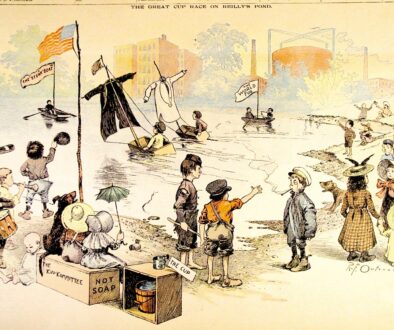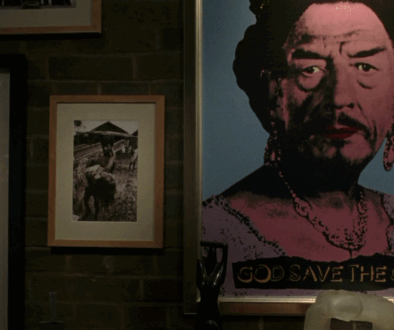This serves as the beginning of the so-called “American Gothic” arc (the name was never actually used in the comics), a storyline in which Constantine leads Swamp Thing on a tour of the United States to confront various classic horror tropes like vampires and werewolves. The timing is apropos – Moore had taken his first trip to the United States in August of 1984, midway through the Arcane arc of Swamp Thing, and the same month that Marvelman ceased publication in Warrior. There he had hobnobbed with DC executives and gotten variously praised and treated as a bit of a golden boy. He hit it off some of the DC staff – particularly with his editor, Karen Berger, and with Julius Schwartz, a long time DC editor, who impressed Moore by having the signature of H.P. Lovecraft in a scrapbook, having served as his literary agent late in Lovecraft’s life. Others proved chillier – Paul Levitz, a fanzine writer who had steadily ascended into upper management at DC, referred to Moore as his “greatest mistake,” a line that, whatever was meant by it in 1984, has bottomless depths of iciness in hindsight.
 |
Figure 470: The aquatic vampires of Rosewood
Illinois. (From Swamp Thing #38, 1985) |
And so it was hardly a surprise that Moore would opt to explore the American-ness of his newfound success. And, given that his success was proving as a horror writer, a tribute to American horror must have seemed wholly appropriate. And on target – Levitz’s words perhaps ringing in his ear, Moore started the arc with a strangely barbed story. The choice of Rosewood, Illinois was not an arbitrary setting. Martin Pasko, early in his Swamp Thing run, wrote a story set in a town called Rosewood that featured Swamp Thing fighting vampires, with a father and son sacrificing themselves to flood the town and drown the vampires. Moore retcons this conclusion, having Constantine explain that there were vampires who hid out in freezers in the supermarket, and who were thus untouched by the running water and could simply wait for the water to become still before emerging. “They’re living down there, in Rosewood, totally unmolested,” Constantine explains. “Having a stable community has opened up lots of opportunities for them. They can settle down, after years of hiding. They can breed.”
 |
Figure 471: Swamp Thing regrows a body that is an entire
mountainside. (Written by Alan Moore, art by Steve Bissette
and John Totleben, from Swamp Thing #39, 1985) |
And so, suitably chastened over his failure to adequately clean up the vampires last time he encountered them, Swamp Thing trudges into the water to fight underwater vampires. This, however, goes poorly, with Swamp Thing being efficiently dismembered by the vampires’ newly hatched giant fish monster. But where this would have been a significant problem in any past issue of Swamp Thing, it instead comes after two issues that have stressed the increasing ease with which Swamp Thing can build a new body, and he reacts to being killed by a giant fish with relative casualness. “It is my own fault,” he thinks. “I am too human in the way I think… in the way I fight. I must learn to exploit the possibilities of what I am.” And after some reflection, he proceeds to reach out over the entirety of Rosewood, incarnating not in a regular sort of swamp monster body, but as an entire landscape, resulting in a fantastic half-page panel from Bissette and Totleben in which Swamp Thing’s visage is stretched out across an entire hillside as he moves the earth, rerouting the river into the lake, and making the water run once again, destroying the vampires for once and for all.
 |
Figure 472: Vampires prove an ineffectual threat to Swamp
Thing. (Written by Marty Pasko, art by Tom Yeates, from
Saga of the Swamp Thing #3, 1982) |
This is, of course, utterly cheeky. Moore in effect reframes an event from before he took over the book just to show how utterly trivial and silly a threat it is under his vision for the book. The overall point of the exercise is clearly, as with several previous stories, to break with the past publication of Swamp Thing, but in this instance the comparison is aggressively direct. Moore is no longer just ripping up the past, he’s pointedly highlighting the difference and positively boasting about what his version of Swamp Thing can do that previous runs couldn’t. Moore is in effect criticizing the Pasko run for the measly nature of its threats, pointing out that his vision of Swamp Thing is so wildly powerful that some pesky vampires simply don’t register.
This sort of negative example carries real weight. The basic plot of “Swamp Thing tours America and encounters stock horror tropes” is, after all, the premise underlying both the original Wein/Wrightson run on Swamp Thing and Pasko’s run. It’s the default mode of Swamp Thing, and while Moore may have contrived to remove the clumsy mechanism of having Swamp Thing jumping freight trains to travel (as he did when arriving in Rosewood the first time), it’s still not instinctively clear why the “American Gothic” arc is a good idea as opposed to the point where it is clear that Moore is out of ideas and has nothing better to do than the most generic Swamp Thing stories imaginable. By initially leaning into that critique by literally revisiting a past Swamp Thing story and then abruptly showing that his take on Swamp Thing fighting vampires is utterly unlike past stories, Moore makes a major statement about what he’ll be doing differently.
 |
Figure 473: The grotesque vampire fish monster. (Written
by Alan Moore, art by Steve Bissette and John Totleben, from
Swamp Thing #39, 1985) |
The effectiveness of this statement rests in part, however, on the fact that Moore makes sure to outdo Pasko’s story in other ways as well. Pasko’s story is ultimately focused on the people of Rosewood fighting back against the vampires, and treats the vampires as wholly knowable and predictable – so much so that there’s not even any descriptions of their horror that can be quoted in order to demonstrate their inadequacies. Their function within the issue is to be generic horror monsters that allow Pasko’s plot about a man so obsessed with fighting vampires he casually sacrifices his entire family to do it. But Moore, despite the fact that he is writing a story that trades in part on the fact that a bunch of vampires aren’t actually a significant threat to Swamp Thing anymore, goes to considerable length to make the vampires scary. The vampire fish monster gets a lengthy description of how it is “massive and bloated, gorged upon its siblings… it pulses and takes stock of its surroundings. It licks pulp from dreadful, splattered talons, and considers what to do next,” for instance. Moore similarly engineers a sequence that plays on many of the same themes of Pasko’s story, inverting a scene of Pasko’s where a kid is attacked by his now vampirized mother by having a vampiric child kill his mother and mock his ineffectual father, a scene with far more perversity and cruelty than any of the corresponding scenes in Pasko’s story. Perhaps most impressively, Moore includes a scene that attempts to generate empathy for the vampires. “Why must we be destroyed,” the vampires ask as they are disintegrated by the running water. “We asked for so very little. Only a home that we could call our own, some livestock to provide our food, and a safe place to raise our children.” The effect is that Moore not only demonstrates that he’s moved past stories like Pasko’s, he also casually demonstrates that he can do Pasko’s stories better than he can as well.
One consequence of the gambit Moore plays out over the course of the two-part vampire story, however, is that he forecloses a large number of story possibilities. After stories like “Rite of Spring” and the initial Floronic Man arc that demonstrated new possibilities, the vampire story was notable as a story that actively tried to close the door on a sizable category of stories. This is a dangerous game – no matter how emphatically and convincingly Moore demonstrates the flaws of the story structure, the fact remains that Swamp Thing has fewer possibilities at the end of issue #39 than it did at the start. Swamp Thing has become so thoroughly powerful that physical confrontation has become essentially irrelevant to the book. The category of things that can be meaningfully treated as threats to Swamp Thing seems, in other words, significantly reduced. And so in many ways the decision to make the next stop in the “American Gothic” tour a werewolf story is surprising, given that werewolves are acutely physical threats.
 |
Figure 474: Phoebe walks through the misogynistic
supermarket contemplating the Pennamaquot’s Red Lodge.
(Written by Alan Moore, art by Steve Bissette and John
Totleben, from Swamp Thing #40, 1985) |
But Swamp Thing #40, “The Curse,” in fact goes a long way towards demonstrating the sort of threat that Moore imagines Swamp Thing facing. On one level, the plot of “The Curse” is simple enough: Swamp Thing arrives in Kennescook, Maine just in time to confront a woman who has turned into a werewolf and gone on a rampage. But the nature of the threat in “The Curse” is not really Phoebe herself, but rather the social structure in which she exists and that fuels a rage that can only be expressed by turning into an eight foot tall snarling death beast. The story opens with Phoebe shopping, buying menstrual pads, and the atmosphere is one of claustrophobia. Moore focuses on the package of the pads, on which “a laughing woman runs through endless fields beneath a cornflower sky,” while the branding proclaims that these particular menstrual pads are “for freedom,” a description that clashes jarringly with the paralleled description of the (fictional) Pennamaquot tribe of Native Americans, which, in Moore’s description, constructed a Red Lodge “upon stilts, that its dark and sullen female power should not taint the Earth.” The purpose of the Lodge is to isolate the tribe’s women during menstruation – within it the women “were forbidden to stand, or lie down, or see the moon. They could touch nothing, even themselves.. they ate from sticks, like lepers, and the gourds that they sipped water from were afterwards smashed and buried without trace.”
 |
Figure 475: Phoebe imagines the rage of the
Pennamaquot women. (Written by Alan Moore,
art by Steve Bissette and John Totleben, from
Swamp Thing #40, 1985) |
Phoebe imagines the Pennamaquot women’s rage at their situation, “their anger, in darkness turning, unreleased, unspoken, its mouth a red wound, its eyes hungry… hungry for the moon” as she walks the aisles – as “the checkout lady places the package in a paper bag, as if to protect her other groceries,” as she walks past a massive sign advertising the “Autumn Morn disposable douche, with the gentle scent of white flowers… for the real woman in you,” and past another advertising the wares of a porn shop, with its images of “numb-eyed women [who] stare through zippered leather masks.” Later, as she and her husband entertain guests, her husband jokes about the lodge, saying that “it was where the Indians sent their squaws when they started getting cranky around that time ‘o the month,” and one of her guests pipes up to insist that his wife not eat any more cookies because “she’s still trying to get her figure back after the kid… and that was two years ago,” and throughout this her rage festers until finally, when her husband confronts her over dinner being late, she transforms into a werewolf and begins rampaging through the town.
 |
Figure 476: Phoebe flings herself at a display of cutlery.
(Written by Alan Moore, art by Steve Bissette and John
Totleben, from Swamp Thing #40, 1985) |
The implication of all of this is made explicit in the story’s climax, where Swamp Thing confronts Phoebe and tries to help her. “I am woman,” she proclaims. “I seek release from this stifling place that has been built for me.” On its most basic level this refers to the Red Lodge whose psychogeographic ghost haunts Kennescook, but more broadly it clearly refers to the systemic oppression that is depicted throughout the issue – one that goes beyond the material cruelty of the Red Lodge and into the bizarre dualism with which the female body is treated, on the one hand eroticized and objectified, and on the other thoroughly rejected, with its natural functions declared shameful and disgusting millstones from which women are encouraged to seek freedom, a freedom that only serves to leave them ready to be objectified and, should they fall short as objects, to be mocked as poor Joannie is for the awful crime of having her body change after giving birth. And faced with all of this, and with the fact that her rage is useless in destroying it, Phoebe opts to fling herself upon a display of steak knives, the image of which provided the issue’s opening panel, with the cruelly ironic slogan “here’s good news for housewives!”
 |
Figure 477: Swamp Thing bears witness to Phoebe’s rage.
(Written by Alan Moore, art by Steve Bissette and John
Totleben, from Swamp Thing #40, 1985) |
Swamp Thing’s role in all of this is ultimately to bear witness to it. Just as Phoebe, for all her animal rage, cannot simply eliminate the systemic oppression of women, nor can Swamp Thing, for all his power. When Phoebe demands release, Swamp Thing is forced to admit that he cannot help her, and it is in the face of this that she chooses to kill herself rather than continue suffering under her rage and indignity. This serve to demonstrate the sort of threat that Swamp Thing, with his newfound powers, is best matched up with: ones in which the underlying problem is not simply a villain in need of punching, but a systemic issue that cannot actually be confronted directly like the reality of female oppression.
“The Curse,” however, was not an uncontroversial story. Indeed, it generated so much response that the letter pages of both Swamp Thing #45 and #46 were devoted entirely to letters regarding the story. For the most part, however, these letters were in favor of the story. The only outright critical letter in Swamp Thing #45 comes from a gentleman in (ironically) Northampton, Massachusetts, and complains that Moore repeats the phrase “hungry for the moon” too often, objects to the story’s generality in speaking for all women, and complains that the display of steak knives is unrealistic (“no market worth its liabilities would ever, ever, never-ever display its cutlery so dangerously”). Of these three complaints it is, in an idiosyncrasy typical of the sorts of people who wrote in to DC letters pages in the 1980s, the steak knives that seem to be the biggest problem. [continued]













September 26, 2014 @ 2:44 am
I remember that letter. How odd, given all the things I have forgotten (or indeed misremembered – I thought the story was called "The Red Lodge").
September 26, 2014 @ 3:07 am
2. The image of the "taboo" person being fed using a long stick is (I am certain) remembered from a colour plate from a children's encyclopaedia published in Britain in the 1950s and entitled "The Book of Knowledge". At any rate,it is a very vivid image from my childhood reading.
September 26, 2014 @ 4:32 am
to be fair, the steak knife display (love that the local supermarket has an enormous array of large, sharp knives pointing out in all directions, like a medieval torture device) is one of the dopiest Moore plot resolutions ever. I agree w/ Wm Keith that the letter was possibly from Moore or an editor admitting how silly it was.
September 26, 2014 @ 4:49 am
In the forward to the Swamp Thing trade paperback containing these stories, Steven Bissette says that he was likewise unhappy about the steak knife display. His parents (I think) owned a grocery store and he knew no grocery store would display the knives outward like that.
In my opinion, it's so very strange that in a story with a message as important as that, the plot device at the story's climax is the number one thing that keeps coming up.
As an aside, will you be expanding on Levitz "mistake" line? I was unaware of that.
September 26, 2014 @ 5:07 am
What an interesting tidbit about Levitz! What was the context, I wonder…
September 26, 2014 @ 7:09 am
I have little trouble believing DC received such a letter, to be fair. Some Googling suggests that the writer wrote into a couple of comics around that time, and looking at the ones I have copies of, none of his other letters have the feel of being plants, so I strongly suspect this one is legitimate as well.
September 26, 2014 @ 7:10 am
Not a lot to expand upon, I fear – Moore was unsettled by the line at the time, feeling it to be a strange thing to say, and the resonance only increased in hindsight.
September 26, 2014 @ 7:39 am
This comment has been removed by the author.
September 26, 2014 @ 7:43 am
Paul Levitz has never really hidden the fact that he never really appreciated the more, shall we say, esoteric directions DC Comics took in the 1980s, which were largely inspired by Alan Moore and the British writers that followed him. Which is somewhat interesting, considering that he was writing Legion of Super-Heroes at the time (probably his most famous assignment as a writer) which was edited by none other than Karen Berger, who was simultaneously editing Moore on Swamp Thing, and was the eventual EIC of the Vertigo imprint.
Beyond that, Levitz and Moore never really got along personally, though I gather most of that had more to do with Moore's disagreements with DC as a whole than with any personal animosity. Levitz was not only one of the top two people in DC's hierarchy throughout Moore's tenure at the company, but he was very much the public face of the organization (Jenette Kahn took much more of a backstage role). If Levitz's didn't understand or approve of the stories Moore generally told, he knew better than to argue with his popularity. And I think there's something to be said for the idea that Levitz, or at least someone with pull at the company, did what he could to respect Moore's achievements and wishes, even after they parted ways. Take the Watchmen situation, for instance: there was a lot of incentive for DC to capitalize on its success, and the collected edition sold like gangbusters, but as long as Levitz remained with the company, very little was done. Not long after he stepped down as president in 2010, DC announced the ill-considered, obvious-cash-grab prequel series Before Watchmen (not all of which was terrible, but which was entirely unnecessary).
In short, my guy (and possibly entirely incorrect) impression in that Paul Levitz is inherently more conservative (in terms of his interests and inclinations, not necessarily his politics) than Alan Moore, but that Levitz was also enough of a professional to avoid letting the fact that he doesn't personally see the appeal of Moore's style affect the direction of DC Comics. During the time when Levitz held power at DC, the approach pioneered by Moore was very much on the ascendant. As soon as Levitz's departed, much of that started getting systematically dismantled (though, to be sure, how much of that was deliberate and how much reflective of larger scale changes in the industry is another question).
September 26, 2014 @ 7:47 am
And on a more basic level, Levitz was always very much a company man, which is a concept Moore, I think, would have looked at with disdain and mild horror.
September 26, 2014 @ 8:57 am
yeah, the "Northampton, MA" seems a very accurate address, given the letter's tone and contents (I know from experience)
September 26, 2014 @ 9:17 am
Thank you, Sean and Philip for your elaboration there.
It seems like such an odd comment.
September 26, 2014 @ 5:29 pm
Paul Levitz is inherently more conservative (in terms of his interests and inclinations, not necessarily his politics) than Alan Moore
Well, he's unlikely to be less conservative in his politics than Alan Moore.
September 26, 2014 @ 10:01 pm
Well, it seems like an odd comment because it is an odd comment. Levitz may not have liked Moore's storytelling, and the two were probably never likely to be personal friends, but Levitz's reputation in the industry is basically sterling otherwise. The situation between him and Moore is arguably the only burnt bridge in his 40 year career in the American comic book industry. The idea that he'd casually insult Moore like this is, without a doubt, odd.
Which leads me to think it was probably a misunderstanding of some sort. Levitz could have been trying to make a joke and misfired badly, or Moore could have misinterpreted what was being said. I mean, it's certainly possible that Moore just rubbed him the wrong way, or that he was just having a very, very bad day, but the fact that it does seem so unusual is what makes it stand out as worth talking about, I suppose.
September 26, 2014 @ 10:30 pm
There is a case to be made that Levitz understood Moore better than anyone else at DC, save perhaps for Karen Berger. And that in Levitz's case, that is ultimately the problem – he recognized before Moore did that Moore was in fact a poor fit for DC.
I mean, the most astonishing thing about that "greatest mistake" comment is that it's been proven so right. Moore really was Levitz's greatest mistake.
September 27, 2014 @ 5:17 am
With Levitz there is the question of what was his involvement in vetoing the UK release of League Of Extraordinary Gentlemen Black Dossier. The arguement given for DC blocking the release was that some of the material Moore & O'Neil was using was still in copyright in the UK, which rather falls apart when they didn't seem bothered about similar potential copyright issues with the Superman/War of the Worlds Elseworlds title they released 9 years earlier.
I seem to recall there was claim of some shenanigans from DC around this at the time, although I'm not sure how much was truth and how much was Lying in the Gutters/Bleeding Cool gossip-mongering. Given the ease at which it was possible to get the book on-line from American suppliers (I think I got mine from Amazon) if they were blocking it as a way to get at Moore it all struck me as a bit shoddy from DC and I'd like to think the President & Publisher of the company was above that sort of thing.
September 27, 2014 @ 7:22 am
Wait… where was that thing about Schwartz that you said last time you were going to include in this one? :-/
September 27, 2014 @ 7:26 am
I didn't say it was in this part. It's in… /checks. Part Sixteen.
September 27, 2014 @ 7:27 am
Oh. Also, just found this essay online, and it's really relevant to what you're writing here, I think: http://www.english.ufl.edu/imagetext/archives/v5_4/condis/
September 27, 2014 @ 7:53 am
I've made a conscious decision to mostly ignore secondary sources for Last War in Albion, just because it was one of the only ways I could constrain the scope of the subject at all (and because so many are so poor), but as you might imagine given my past association with ImageTexT, I am aware of this one, and indeed will make a somewhat more succinct version of this argument next post.
September 27, 2014 @ 7:55 am
(Though, to be clear, a version I assembled by looking at several sources. But Condis's article was an influence, so good find.)
September 27, 2014 @ 8:21 am
Fair enough. Do you think Moore would've included the Native American aspect of "The Lodge" had he known more about real Native American cultures?
September 27, 2014 @ 9:52 am
The problem with some of the more salacious rumors surrounding the Black Dossier fiasco, in my opinion, is that it's not clear who actually stood to profit from the thing. If DC executives were doing it to screw around with Moore, then it's weirdly late, limited, and self-defeating. LoEG was a fairly high-profile property, after all, and blocking its publication because of a corporate (or personal) feud with one of the creators is a bit odd. Not impossible, but it's a bit of a logical leap without some compelling evidence. Plus, it's not like this seems to rank very highly on Moore's personal laundry list of grievances with DC: he seems to cite his complaints over the marketing of the V for Vendetta movie or the modifications to the first LoEG volume far more frequently.
Also, I had thought it wasn't the UK copyrights that were an issue. It appears that despite DC's original statement that the book wouldn't be published outside of the US, it did see a British release. The problem seems to have been with other countries. Which means the comparison to Superman: War of the Worlds might not even be applicable. The publication of the two books was quite different (the Superman title was basically a glorified periodical that might not have gotten substantial overseas publication to begin with, Black Dossier was a proper hardcover release that, due to the high profile of both Moore and the project itself, would have normally gotten a much wider release. And even if that's not the case, there are any number of other ways to explain why DC's stance might have changed in the eight years between the two releases (it might not have specifically been the H.G. Wells copyrights that DC was concerned about, or the new found cautiousness could have been a direct result of problems caused by the earlier release).
February 19, 2015 @ 12:36 am
This comment has been removed by the author.
February 19, 2015 @ 12:43 am
I have to be honest that as a teenage boy in scotland I didn't really think about the problem with the knives being on display the way they were at the resolution.
The thing that really got me about this story was, albeit through the prism of horror, got me thinking deeper about issues I had been formulating gradually in my own head. Potent story.
February 19, 2015 @ 12:55 am
Oh and I meant to add that as I am seeing some of this earlier colour work for the first time (I saw later stuff), the work of Tatjana Wood is just simply so lovely, subtle and amazing. Some of the best colour work I've seen.